introduction
External forces causing internal change. That is what drives a narrative. Exploring narratives this quarter was an interesting experience. After sheltering in place for just around a year, I feel that my life is somewhat devoid of external forces. Internal change seems to occur at a slower rate. For me, writing narratives for English and Film class and then creating visual representations in Digital Media became a journey into childhood, a time when experimentation and creativity leads us to force change within ourselves.
During this unit, we explored storytelling through different media, including writing, digital art, storyboarding, audio, and film. In doing so, we were able to learn to use modern professional equipment and applications such as the Wacom Digital Drawing Pad, Adobe Photoshop, Adobe Illustrator, Adobe Premiere Pro, Adobe After Effects, and Avid Pro Tools.
story
Our assignment for this story was to write a “flash fiction”: a very short story that still managed to convey a plot and character(s). When I sat down to write this story, I knew I wanted to first develop a strong, spunky character who would then guide me towards an interesting plot. Prompted by the “Character Questionnaire” provided by Mr. Greco, I began writing an imaginary interview transcript in the first person, adopting the tone and vocabulary of a five-year-old girl with a big imagination. This character interview turned out to be longer than the actual story; I wrote about small details I knew I wouldn’t be able to include due to the constraints on length. However, developing these details was part of the process, as they allowed me to envision a more three-dimensional character.
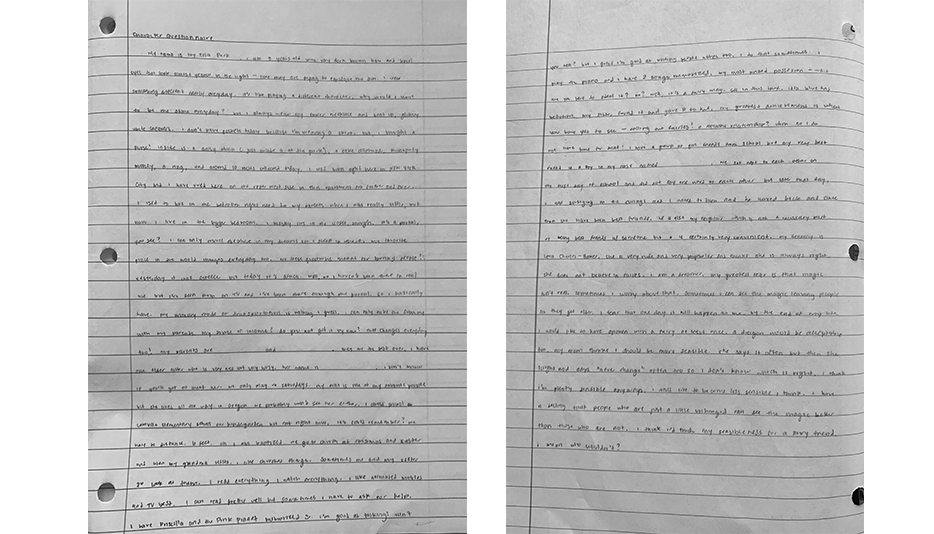
After I had a clear image of my character in mind, I brainstormed a conflict that would be in line with her personality and highlight the unique aspects of her identity. The plot that formed was one of magic, love, and family. Below, I’ve attached a rough plot map I drew in my notebook before sitting down to write the story.

When I was in elementary school, I spent almost all of my lunch and recess breaks in the library. My elementary school librarian had a gift for finding just the right books to make kids fall in love with reading, and she certainly worked her magic on me. When I became an “upper grader”, I started reading stories to the “lower graders” at school during break times, and I loved watching their little faces light up with emotion as the story progressed.
While recording my own short story, I decided I would try to record it all in one take, with as few mistakes as possible. I wanted to be in the moment while I was reading instead of depending on the software to cut out my mistakes. I wanted the audience to feel the emotions, the story, the connection between reader and listener. So, sitting in my closet with the door closed, I read aloud and pretended the little kindergarteners were sitting in front of me: giggling and whispering and shifting around on rainbow carpet squares. Later, I added in effects — wind, birds, city noise, sparkles — to help make the world come to life.

There is something beautiful, nostalgic, and bittersweet about listening to a story rather than reading it. It reminds me of being a little girl, tucked into bed, asking for one more story before I had to go to sleep. I think that we don’t often get read aloud to after a certain age, so listening to a story brings back those childhood memories, establishing a sense of intimacy and care.
There Are Fairies In The City
Ivy made a snowball move with her mind. It was a warm January day in New York City, and the snow was melting. White was quickly giving way to brown.
Ivy squinted at one remaining snowball, pure and magical, focusing on it with all her might. Yes! Ivy observed that the snowball had moved slightly to the right. She smiled triumphantly.
Ivy looked up at her mom, who was still chatting with a friend. She glanced at her big sister Rose, who had her nose in a book. Neither witnessed the incredible feat.
Finally, Ivy’s mom waved goodbye to her friend before looking down to smile at her 5-year-old’s characteristically odd outfit: sweater, puffer coat, skirt, leggings, and sneakers.
Hand in hand, the trio began their short journey home. Ivy related her newfound magical powers and the snowball that moved. Her mom laughed and told her that was very impressive. Encouraged by this response, Ivy revealed her new plan: she was going to summon the fairies. Her mom said don’t be silly there are no fairies in the city and anyways it’s winter and fairies like spring please Ivy try to be more sensible and focus a little more on school and a little less on fairy plans. Seeing that Ivy had worked herself into some sort of lecture, Rose offered support with a sympathetic smile.
Ivy scowled. She would go on with her plan anyways.
Once home, Ivy got to work. She grabbed her pink silky bag, her black velvet pouch filled with white stones from the neighbor’s front yard, and her most prized possession: a little blue fairy wing that her sister had found in Central Park. It was encased in a purple jewelry box hidden deep in Ivy’s closet. Ivy kissed the box and placed it carefully in her bag. She changed into her pink party dress, popped on her winter coat, slipped on her sneakers, and marched out.
At the door, Ivy paused. She should probably leave a note for her mom or sister. Unfortunately, the only thing she could write properly was her name. She sighed and walked to Rose’s room.
Announcing her presence with a curt hello, Ivy explained her plan to go to Central Park and see the fairies. She then turned and marched out, feeling very responsible.
A slow smile spread across Rose’s face. She called out to remind Ivy that fairies like flowers so probably bring some. Oh and she should look both ways before crossing the street.
Ivy admonished herself for not having thought of flowers. She knew exactly where she could pick some up on the way.
Per-plop, per-plop, per-plop went Ivy’s sneakers against the muddy sidewalk as she skipped to keep warm.
If people looked strangely at the little girl in the fancy dress and winter coat, Ivy did not notice. She was entirely occupied with thoughts about her plan.
Aha! Ivy spotted what she was looking for. A window box. Ivy tiptoed up and picked five flowers carefully so you could hardly tell any were gone. She tiptoed away, beaming at her success.
Her good fortune did not last. A mom of a school friend was walking her way. She tried to hide behind a trash can, but her disguise failed. When the mom asked if she was lost, Ivy knew she had no choice but to sprint away.
Tired from skipping, Ivy walked the rest of the way. Central Park! It was half white and half green-brown, but Ivy took in the view with sparkling eyes.
Ivy spotted the perfect tree. She rushed over to begin preparations. She took out the pouch of white rocks, carefully shaking them into her hand. She arranged them into circles, with a flower in the center of each. In between, she placed the open box with her beautiful blue fairy wing. She knew she wasn’t supposed to touch it, but she couldn’t resist. She reached out a small finger and brushed it gently. It was time.
Standing up, Ivy began the final ritual. Eyes closed, Ivy danced: leaping, floating, twirling around the tree with joyous abandon. Peeking with one eye open, Ivy searched for the fairies.
But there was nothing. Just trees and mud and people. A tear of disappointment fell. She gave one last half-hearted spin. Perhaps fairies did not like winter in the city. Maybe she should focus on school and acting sensible after all. Ivy sighed and opened her eyes.
All around her, flower petals and sparkles showered down. Her heart soared skyward, leaping out of her chest, reaching toward the fairies who had answered her call. She twirled around with arms outstretched, her smile glowing. She was magic.
What Ivy couldn’t see at that moment was Rose, sitting up in the tree, sprinkling petals and glitter from a Ziploc bag. Her smile glowed as she looked down at her little sister. After Ivy announced her plan, Rose had gathered materials before following her sister to the park. She waited quietly behind a nearby tree as Ivy set up her rocks and flowers, and then saw her opportunity when Ivy closed her eyes to dance. She shimmied up the tree and made it just in time to sprinkle her fairy dust.
Someone on the street that day remarked at a funny sight. One little girl in a fancy dress and one older girl in regular clothes walking past, not side by side but one in front of the other. What caught the attention of the passerby was the identical smiles that the two wore, like they had just seen, in the words of the observer, “the most beautiful and rare sight in the world! From the looks on their faces, you would’ve thought they’d seen a unicorn or a fairy! Certainly not the mud and gloom of melting snow in the city.”
The two girls did experience something beautiful that day, something that shouldn’t be rare but often is. I hope you experience it sometime soon.

illustrations
For this project, we were given a lot of freedom on what to design and had the opportunity to choose a tangible form for our designs to be made into. After practicing using Illustrator and the Wacom Tablet, we were finally ready to be creative in the design process and create a real, useable product. Of the options given, designing a sheet of stickers immediately stood out to me, and I was so excited to begin, brainstorming all of the different options.
I have loved stickers since I was little. For some reason, stickers have always seemed to be a precious and valuable thing to me. When I was little, I would never use the stickers I got from doctor’s appointments, school projects, Valentines cards, etc. Instead, I would save them in a drawer in my room where they would lay, safe but unused.
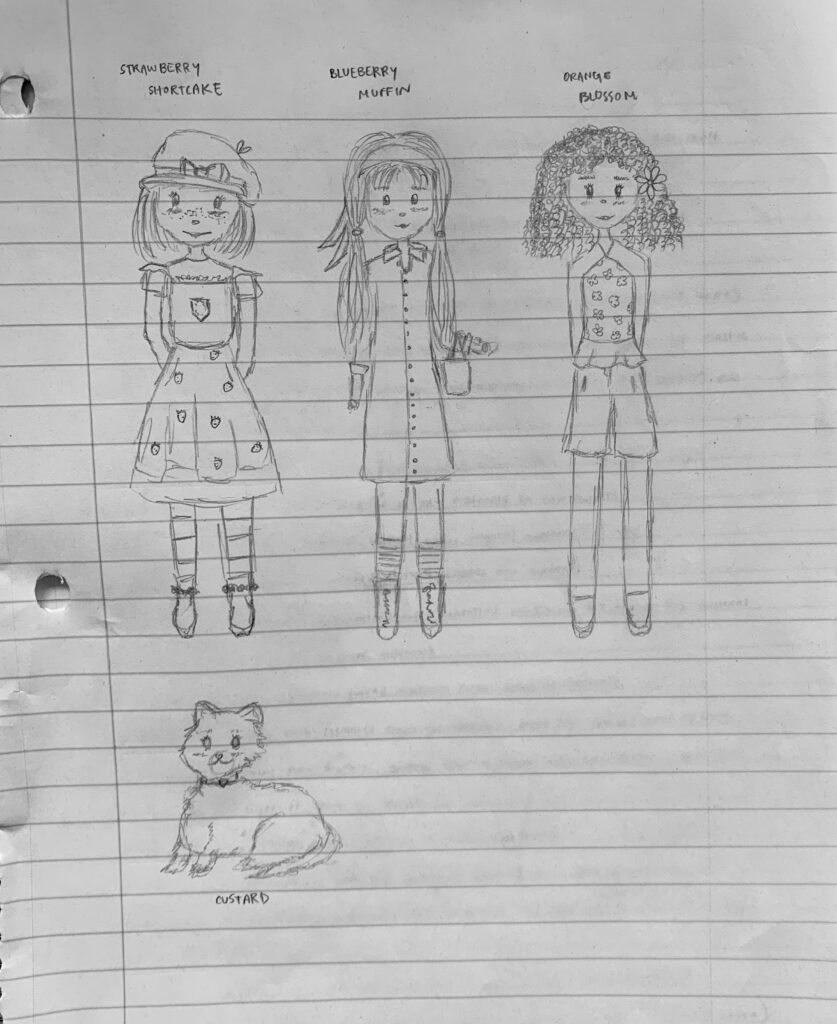
I used to live in Ohio, and in my room there, I had my walls decorated with Strawberry Shortcake character stickers. Strawberry Shortcake was probably my favorite show growing up, and I watched four different versions at various stages of my childhood (1980, 2003, 2007, 2009). My little sister and I still pop in a DVD occasionally and watch some episodes. My brothers will watch too, but it takes a little more convincing ;).
Recently, my little cousin made me aware of a new version of Strawberry Shortcake being shown on TV now, and I was excited to discover that she was watching the same characters that I had grown up with. Unfortunately, that excitement dissipated when I saw the re-designed characters. Frankly, I found them to be an appalling departure from the cute characters I had grown up watching.
For this project, I decided to combine these two loves and design new versions of some of these iconic characters (Strawberry Shortcake, Blueberry Muffin, Orange Blossom, Lemon Meringue, Plum Pudding, Huckleberry Pie, Custard, and Pupcake) in the form of stickers, similar to the ones I had grown up with on my bedroom wall.
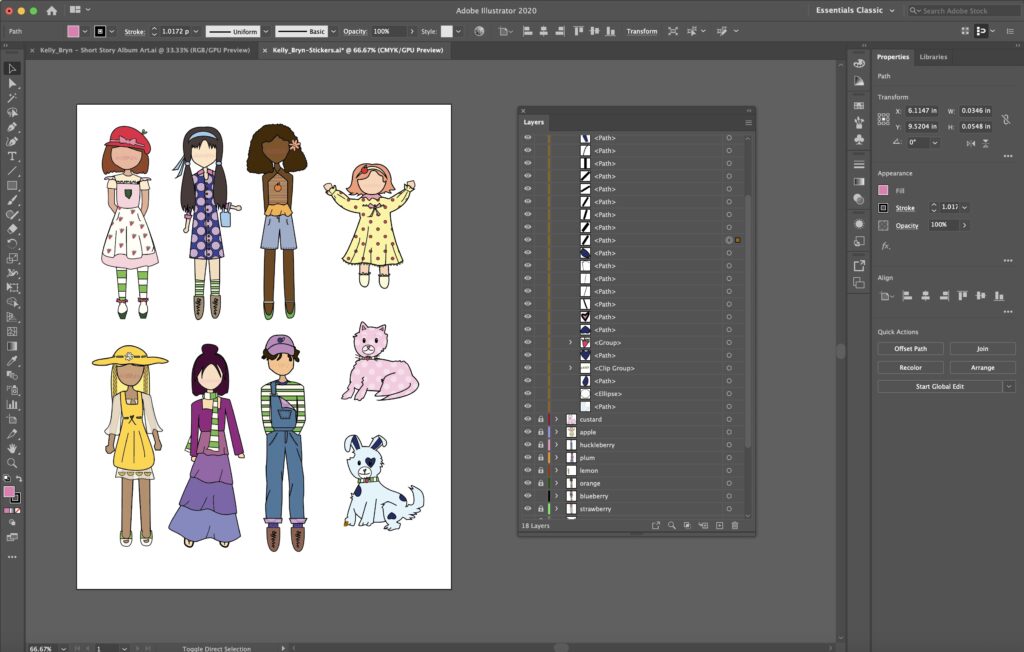
The process of creating the stickers was genuinely so much fun. I was able to combine my love of fashion, character design, history (of the characters/TV show) and kids’ shows into a tangible product. Reviewing all of the different versions of the show, I was able to reimagine the characters in a new way while still incorporating aspects of their traditional outfits. Illustrator allowed me to include so many different patterns and details to create the best possible product, and I certainly gained an appreciation for the amount of work it takes to design a character.
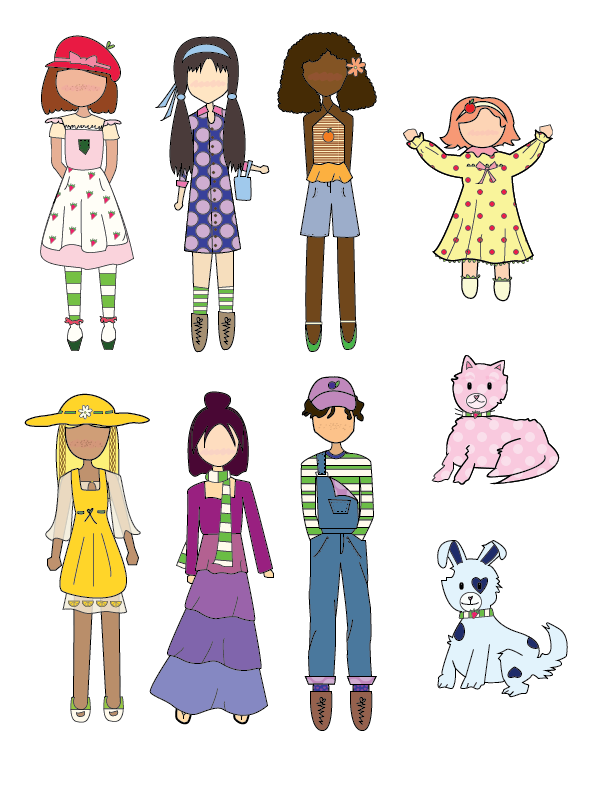
Though they could certainly be improved upon, I love the way the stickers turned out. I showed them to my little cousin and she wants a sheet of the stickers, so I definitely consider that a success! I look forward to introducing her to the versions of Strawberry Shortcake I grew up with when the pandemic situation calms down enough to allow us to sit down in front of a TV together.
music
I am not a musician. Not even close. For this project, we were assigned to write and record a parody song using ProTools, which, to me, seemed impossible and a recipe for embarrassment. While it did not turn out to be impossible, it is certainly embarrassing, as I am a truly horrible singer. My sister sat in the room next to me as I recorded, and cried of laughter at my futile singing attempts.
In 6th grade, I was able to see the original cast of Hamilton on Broadway due to my incredibly organized mother who had gotten tickets for us to see Broadway show when she was planning our spring break trip in the fall. She researched and chose Hamilton. Shortly after, the musical became a sensation. That night was one of the most magical nights of my life. I had all of the words memorized and mouthed them as I watched them performed onstage, even catching a tiny mistake made by Lin Manuel Miranda during “Helpless”.
Lin Manuel Miranda and I share a birthday, and it is my one claim to fame. When I was thinking of what song to parody, Miranda’s work immediately came to mind, partially because I would rather rap than sing but mostly because his songwriting is absolutely genius. He played the lead role in the most successful Broadway musical of all time. Yet, he is not a professional singer at all.
I decided to take inspiration and comfort in this fact (although he is far better at singing than me), and do my parody song to a tune I know by heart: “Alexander Hamilton”. And what better subject matter than a story we all know by heart? Below are my lyrics for my hit song “Cinderella”:
How does a servant
Orphan, daughter of two peasants, cautious
Trapped in the kitchen of her stepmother’s house with just resilience and conversations with some helpful mice
Grow up to a princess with no price?
A fairy tale
Cooking, cleaning without her pay
She was struggling to keep angry feelings at bay
She was working but all she wanted to do was play
She was hoping for a prince to come and save the day.
And everyday while girls her age went out to party she stayed
Scrubbing away
She struggled and kept her guard up
Inside she was longing for freedom joy and her honor
All she needed was a pumpkin, magic, and some martyrs.
But her stepmother came
And devastation reigned
The girl who saw her future drip dripping down the drain
Put her head in her hands sat down to cry out in pain
Then her fairy godmother came and magical sparkles rained.
Well the word got around
They said this girl must be saved, man
Took her to the ball glass slippers just to show she came, man
Get your prince and marriage
Don’t forget to run away
And the world’s gonna know your name
What’s your name yeah?
Cinderella, yes I am.
My name is Cinderella, here I am.
Look there’s my stepmother and my sisters
They will pay, They will pay.
In Digital Media, we learned how to remove (or make as unintelligible as possible) the vocals of the original song in order to then record our new lyrics over them.

Finally, I ended up with my final product which is attached below. Listen at your own peril 🙂
film
We started our narrative unit with achieving a basic understanding of introducing a story using Griffith’s Pattern. DW Griffith revolutionized film with Birth of a Nation in 1915, a 3 hour and 15 minute long narrative film (which is unfortunately reflective of some of the extreme racist views of the time). This feature length film stretched the boundaries of film far beyond what had previously been imagined and provided the basis for the pattern of storytelling we see in films today. Griffith’s Pattern introduces a storyline by showing a wide shot of the setting, followed by a wide shot of the scene, and then introductory medium and close-up shots of the characters.
Our next tool in narrative filmmaking was editing and pacing. Listening to interviews and watching clips from Alfred Hitchcock’s films helped us understand the power of editing in getting the audience to feel the emotions that the story is trying to convey. Specifically, we studied how a faster pace and variety of clips in editing can develop suspense, as Hitchcock famously did in many of his films.
Next, we delved further into our studies of film language by learning about the 180 Degree Rule, eye lines, and continuity. To practice these essential skills, we created a chase scene, first watching some iconic chase scenes from various movies (including Back to the Future 2) for inspiration.
Finally, we were ready to move on to our big assignment: a narrative film without dialogue. Drawing inspiration from the theme of my narrative story that I wrote for English, I developed a concept for my film. Below is my original synopsis:
The setting of the film is established with Griffith’s Pattern. These preliminary shots of the neighborhood and house demonstrate that the setting is fairly ordinary. Inside the house are a little girl and a stuffed bunny sitting across from each other at a table. They are playing chess. The girl looks intensely at the bunny. She moves a pawn forward. The bunny does not respond. She stares more intensely. The bunny still doesn’t respond. The bunny’s chess pieces remain in the same position.
So, the girl and the bunny draw instead. The girl’s mother (her face is not shown in the film, only her legs/feet such as in children’s books) lays out a blanket, and the girl and the bunny sit in the grass with markers and paper. The viewer watches from a distance as they work. When the girl looks up, she sees the bunny in the same position with a blank sheet of paper in front of it. She displays her artwork to the bunny. It is a colorful, decorated picture that says one word: MOVE.
Frustrated, the girl retrieves a small plastic chair, tapes on a piece of paper displaying the words, “TIME OUT”, and props the bunny up on the chair. She then goes back inside, indignant. The bunny remains still as the little girl peeks at it suspiciously through the windows.
Looking at the clock, the girl realizes it’s lunch time. She would not deprive the bunny of lunch, so she brings the bunny back in to eat with her. Her mom gives her and the bunny food. At the end of lunch, the girl’s plate is empty, and the bunny’s plate is full.
The girl has not lost hope yet. Throughout the rest of the day (montage), the girl and the bunny skateboard, play cards, go on the swings, play basketball, bake cookies (with parental guidance), and play dress up until the sun sets.
As the sun sets, the girl’s mood dips along with it. She lays on her stomach with her head propped up on her hands and her feet swinging in the air staring at the bunny, frustrated and tired. The bunny looks back, void of emotion. She flips to lay on her back. She does not want to look at the bunny anymore.
The moon is peaking through the living room window. It’s time for bed. The girl brings the bunny with her to brush her teeth. She starts to offer the bunny a toothbrush, but at the last minute hesitates and takes it back. She puts the bunny under its blankets and lays down on her own. Her mom comes in to tuck her in, and lays down with her to read a story. As she reads, the girl doesn’t pay attention, opting to stare dolefully at the bunny instead. The mom leaves, brushing her hand against her daughter’s forehead and patting the bunny on the head. The girl is still staring at the bunny. The lights go out.
Bright light shines through the window. It is morning. The little girl wakes up to find that her bunny is not in its bed! Confused and hopeful, she runs out of bed and looks around the house. Finally, she finds her bunny sitting at the table with the chess board out. The bunny is dressed up in a little scarf and hat (an outfit from playing dress up the day before). On the chair, a drawing of a heart has been taped up. A pawn on the bunny’s side has been moved forward.
The girl is shocked, but a smile slowly spreads across her face. Her mom’s feet can be seen in the background. Beaming, the girl promptly pulls out a chair, sits down, and moves one of her pawns forward.
I learned so much while making this film. Due to covid restrictions and guidelines, I generally had to rely on my own judgement and memory during filming which was certainly a challenge. To make sure I got all the shots I needed, a lot of planning was required. Storyboarding was instrumental in helping me ensure continuity and a well-executed final product.
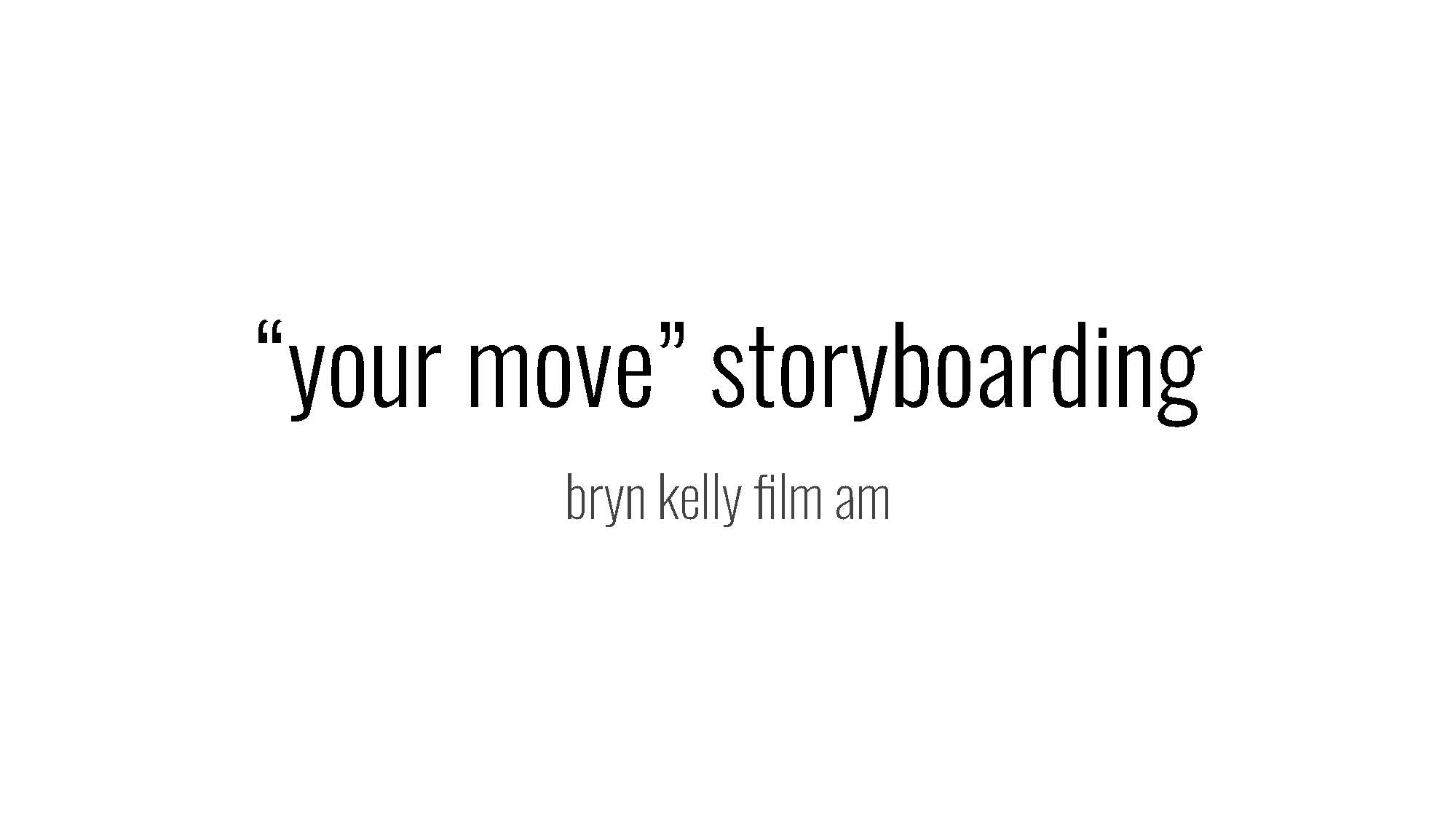
In total, I only really spent 3 days shooting the film (over the course of a few weeks), but those days were very long and entailed constant shooting, organizing, and problem solving. I needed to make sure I was as efficient as possible while still coming out with a quality product, and I felt the added pressure of not wanting to waste my actor’s time. Since I was working with a young actress (unlike my experimental film where I worked with a friend), I had to give much clearer directions and be more assertive on what I wanted to happen in each shot. Telling a story visually initially felt like a huge challenge, but in doing so, I became much more aware of the subtler aspects of film language.
I think the film, in many ways, captured some of the feelings evoked by this pandemic: seeking connection, feeling frustration when things are unable to fill that void of loneliness, experimenting and trying new things, and finding out that sometimes the things that we seek are already there for us.